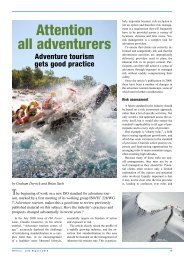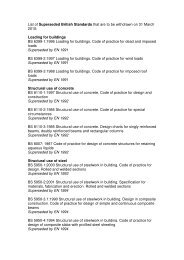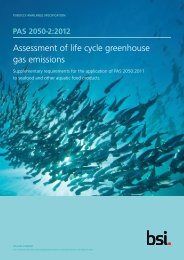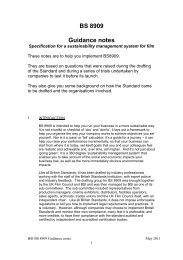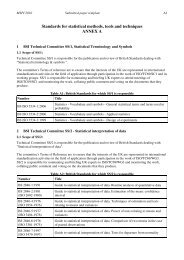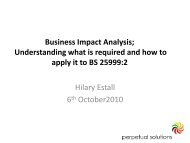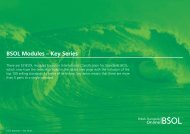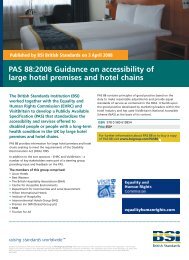Download the first chapter - BSI Shop - British Standards Institution
Download the first chapter - BSI Shop - British Standards Institution
Download the first chapter - BSI Shop - British Standards Institution
Create successful ePaper yourself
Turn your PDF publications into a flip-book with our unique Google optimized e-Paper software.
First published in <strong>the</strong> UK in 2006Second edition 2007 by <strong>BSI</strong>389 Chiswick High RoadLondon W4 4AL© <strong>British</strong> <strong>Standards</strong> <strong>Institution</strong> 2006, 2007All rights reserved. Except as permitted under <strong>the</strong> Copyright,Designs and Patents Act 1988, no part of this publication may bereproduced, stored in a retrieval system or transmitted in anyform or by any means – electronic, photocopying, recording oro<strong>the</strong>rwise – without prior permission in writing from <strong>the</strong>publisher.Whilst every care has been taken in developing and compilingthis publication, <strong>BSI</strong> accepts no liability for any loss or damagecaused, arising directly or indirectly in connection with relianceon its contents except to <strong>the</strong> extent that such liability may not beexcluded in law.The right of <strong>the</strong> contributors to be identified as <strong>the</strong> authorsof this Work has been asserted by <strong>the</strong>m in accordance withsections 77 and 78 of <strong>the</strong> Copyright, Designs and Patents Act1988.The authors have made every effort to seek permissions for allmaterial used. Any omissions that are drawn to <strong>the</strong> attention of<strong>the</strong> publisher will be included in any future editions of <strong>the</strong> book.Typeset in Sabon byFlorence Production Ltd, Stoodleigh, DevonIndex compiled by Indexing Specialists (UK) LtdPrinted in Great Britain byMPG Books, Bodmin, Cornwall<strong>British</strong> Library Cataloguing in Publication DataA catalogue record for this book is available from<strong>the</strong> <strong>British</strong> LibraryISBN 978–0–580–50346–7 2nd edition(ISBN 0–580–43777–9 1st edition)
11112345678910111231114567892011112345678930111123456789401111111List of FiguresList of TablesNotes on <strong>the</strong> ContributorsContentsForewordSteve Fowler, CEO, Institute of Risk Management1. Surveying <strong>the</strong> Risk Management Universe– Where Are We Now? 1David Hillson2. Strategic Risk Management 10Richard Anderson3. Corporate Governance 42David Smith and Rob Politowski4. Financial Risk Management 68David Bobker5. Business Continuity Management 98John Sharp6. Reputational Risk 128Arif Zamanviixxixix
viContents7. Risk-assessed Marketing Planning 157Terry Kendrick8. Operational Risk Management 185Keith Blacker9. Project Risk Management 212Stephen Ward10. Environmental Risk Management 241Simon Pollard and Peter Young11. Legal and Contractual Risk Management 266Anthony Cherry12. Technical Risk Management 294Tyson Browning13. Managing Fraud Risk 323Jon Finch14. Counter-terrorism Risk Management 352Richard Flynn15. Understanding The Risk Management Universe –Consensus and Controversy 377David HillsonIndex 387
11112345678910111231114567892011112345678930111123456789401111111Figures2.1 Relationship of attribute to long-term performance 282.2 Balanced risk: mapping all four attributes 292.3 Enron risk culture 292.4 UK plc risk culture? 302.5 Target risk culture? 312.6 COSO: elements of control 322.7 COSO: <strong>the</strong> enterprise control framework 332.8 A new approach to controlling risk 343.1 Components of successful corporate governance 443.2 Corporate governance organigram 523.3 Relationship between threat and opportunity 533.4 Process for managing threats and opportunities 563.5 Risk matrix 583.6 IMS model 654.1 BP Ordinary share price 4 Jan 1993 – 31 Dec 2004 714.2 US$/GB£ Rate Oct 1993 – Apr 2005 724.3 Three-month US Treasury Bill rate 1954–2005 734.4 Four simulated Brownian sample paths 734.5 The normal distribution assumed for market risk 754.6 One-sided loss curve – credit risk/operational risk 764.7 Simulated total corporate profit 835.1 External drivers for introduction of BCM 1015.2 BCM as a unifying process 1055.3 The BCM life cycle 1065.4 Possible BCM structure 1075.5 High-level process mapping example 1105.6 Detailed process mapping example 1105.7 Mapping resources to critical activities 1115.8 Example of a risk matrix 112
viiiFigures5.9 Frequency of BCP rehearsals 1225.10 Results of BCM rehearsals 1225.11 Business continuity plan exercise process 1246.1 Stakeholder expectations 1296.2 Business challenges 1306.3 Trust in leaders 1316.4 A model of business relationships 1326.5 Two ways to think about a business 1346.6 Reputational risk and value creation 1356.7 Customer loyalty across BTC and BTB markets 1376.8 Customer, corporate and brand values 1396.9 The six components of stakeholder sensitivity 1537.1 The marketing planning process and risk 1617.2 Addressing risks to <strong>the</strong> customer portfolio 1717.3 A probability and consequences matrix for marketingplanning 1758.1 The jigsaw of operational risk responsibility 1898.2 Core operational risk management model 1918.3 Information flow for an incident database 1938.4 Approaches to measuring operational risk 1969.1 The SHAMPU process: flow chart portrayal 22810.1 Fundamental concept of risk management showingregions of high (H), medium (M) and low (L) risk andobjective of risk management 24210.2 Framework for environmental risk assessment andmanagement 24610.3 Example conceptual model showing potentialenvironmental exposures at a petrol retail forecourt 25610.4 Example event tree for <strong>the</strong> release of flammable liquidfrom a process facility 25710.5 The risk hierarchy from strategic to operational risk,applied here to <strong>the</strong> water utility sector 26111.1 Illustration of crisis handling costs 27111.2 Typical process flow 27812.1 Example of a traditional process for managingtechnical risk 29612.2 Standard risk model 29712.3 Expected loss formula 29812.4 Risk exposure in terms of probability and impact 29912.5 Example risk reduction profile 30012.6 Risk decreases with availability of useful information 302
Figuresix1111234567891011123111456789201111234567893011112345678940111111112.7 Example TPM tracking chart for UCAV mission range 30512.8 Conversion of week zero’s three-point estimate totriangle distribution 30712.9 Triangle distribution function showing relativeprobability of various range TPM outcomes atproject start 30712.10 CDF for UCAV range TPM 30812.11 Utility curve for aircraft range 30912.12 Reduction in unacceptable outcomes from week 0 toweek 14 31412.13 TPM profiles and risks during <strong>the</strong> UCAV preliminarydesign project 31612.14 Overall risk profile for <strong>the</strong> UCAV preliminary designproject 31713.1 A schematic overview of <strong>the</strong> cyclic Fraud RiskManagement Plan 34114.1 Legal definition of terrorism 35914.2 Terrorist attacks worldwide – by sector 36014.3 Sources of information about terrorism 36314.4 The components of a resilient business 36714.5 The risk matrix 370
xiiNotes on <strong>the</strong> Contributors<strong>the</strong> UK Financial Services Authority, where he has responsibility for allcorporate governance matters.Dr David Bobker MA DPhil ACA is founder and Director of RealAssurance Risk Management (http://www.realassurance.com) whichspecializes in risk management, regulatory compliance, corporate governanceand internal audit, delivering both consulting and training. Heholds a First Class BA, MSc and DPhil in Ma<strong>the</strong>matics all from OxfordUniversity and is a Chartered Accountant.David has spent a long and varied career in <strong>the</strong> financial servicesindustry where he worked as an external auditor and an internal auditor(having been Head of Group Audit both for Alliance & Leicester plcand Norwich Union plc). He has authored a number of articles on internalaudit and spoken widely at conferences in <strong>the</strong> UK and abroad. Hisinterests also include corporate governance, having taken a keen interestin <strong>the</strong> original Turnbull consultation, and compliance, having beena group compliance officer and a supervisor at <strong>the</strong> Building SocietiesCommission (now part of <strong>the</strong> FSA) with responsibility for capitaladequacy rules.As well as supplying outsourced internal audit services, his recentconsulting work has included quantified risk analysis and systems forclients. Always taking a keen interest in IT, he has now developed specialistMonte Carlo modelling software for <strong>the</strong> assessment and managementof operational risk, as well as carrying out credit and marketrisk assignments. The o<strong>the</strong>r active area of work is training where overa three-year period he has delivered specialist courses on quantifiedrisk methods to over 200 senior internal auditors and operational riskmanagers.Dr Tyson R. Browning is Assistant Professor of Enterprise Operationsat <strong>the</strong> M J Neeley School of Business at Texas Christian University inFort Worth, Texas, USA. He teaches Operations Management (MBACore) and Project Management (MBA elective) and conducts researchon enterprise operations, process modelling, product development,project management, engineering management and systems engineering.He previously worked for Lockheed Martin Aeronautics Company,where he was <strong>the</strong> technical lead and chief integrator of <strong>the</strong> enterpriseprocess architecture and author of company policies and processesdriving <strong>the</strong> transition to a process-based company. Before joiningLockheed Martin, he worked with <strong>the</strong> Lean Aerospace Initiative at<strong>the</strong> Massachusetts Institute of Technology, conducting on-site research
Notes on <strong>the</strong> Contributorsxiii11112345678910111231114567892011112345678930111123456789401111111at Boeing, Texas Instruments, General Electric, Daimler Chrysler andseveral o<strong>the</strong>r companies. Browning has also worked for HoneywellSpace Systems and Los Alamos National Laboratory. He received aBachelor’s degree from Abilene Christian University and two Master’sdegrees and a PhD (in Technology Management and Policy) from MIT.He has authored over 20 papers on engineering management, riskmanagement, <strong>the</strong> design structure matrix, organization design, processmodelling and value measurement – publishing in IEEE Transactionsin Engineering Management, Systems Engineering, Project ManagementJournal, Technology Management Handbook and o<strong>the</strong>rs. He is amember of <strong>the</strong> International Council on Systems Engineering (INCOSE)and <strong>the</strong> Institute for Operations Research and <strong>the</strong> Management Sciences(INFORMS), and he also serves on <strong>the</strong> Editorial Board for SystemsEngineering.Anthony Cherry is a Partner in <strong>the</strong> national law firm, BeachcroftWansbroughs. After graduating in Law from Manchester University in1976 and serving Articles in <strong>the</strong> City he worked for three years in <strong>the</strong>legal department of ICI. Since 1983 he has been with his present firmand its predecessors. He is responsible for developing and deliveringservices, including Risk Counsel, which bring legal skills and experienceto bear on business risk and opportunity in new and flexible ways.He also chairs <strong>the</strong> firm’s Risk Management Directorate and contributesto its policy on Corporate Social Responsibility. He lives in Clevedon,North Somerset with his wife and three children.Jon Finch retired in 2002 after 31 years in risk management, mostrecently as ICL/Fujitsu Services Group Business Risk Manager wherehe carried corporate responsibility for business risk management policyand processes. Based in corporate Internal Audit he worked to achieveprotection against business risk. Jon Finch is well regarded within <strong>the</strong>UK risk management community as a specialist in business risk andpractical business problem resolution. He was employed in commercefrom 1961, in <strong>the</strong> UK Electricity and Gas Industries before ICL, initiallyas an accountant and later in IT system design and development. Afterjoining ICL in 1971 he performed a significant number of internal andcustomer related troubleshooting assignments on behalf of <strong>the</strong> Board ofICL, of STC, and on secondment to major clients. Over <strong>the</strong> years Jonhas succeeded in resolving crises in over 40 mainly litigious situationson behalf of ICL in 18 countries including Hong Kong, South Africa,New Zealand, Malaya, France, Germany, Hungary and Portugal.
xivNotes on <strong>the</strong> ContributorsJon is semi-retired, writing and speaking on business risk managementtopics. He has <strong>the</strong> reputation of being an entertaining speaker inhis field. He is married to an actress, has three children and lives in<strong>the</strong> Fens near Cambridge.Richard Flynn BSc (Hons) MSc RGN FRSA is a serving Police Officerand is currently seconded to a national police unit providing protectivesecurity advice to <strong>the</strong> business community. He is <strong>the</strong> author ofnational guidances ‘Expecting <strong>the</strong> unexpected’ and ‘Secure in <strong>the</strong> knowledge’,both written to aid <strong>the</strong> business community in <strong>the</strong> developmentof security and business continuity plans. He has a wealth of experienceworking with <strong>the</strong> business community and his research interestsinclude how organizations perceive and manage risk, and how crimeprevention strategies can assist in <strong>the</strong> prevention of terrorism.Dr David Hillson PMP FIRM FAPM MCMI is an international riskmanagement consultant, and Director of Risk Doctor & Partners(http://www.risk-doctor.com). He is a frequent conference speaker andauthor on risk. David is recognized internationally as a leading thinkerand practitioner in <strong>the</strong> risk field, and has made several innovativecontributions to improving risk management. He is well known for promoting<strong>the</strong> inclusion of proactive opportunity management within <strong>the</strong>risk process, and has recently been working on applying emotional literacyto understand and manage individual and corporate risk attitudes.David is active in <strong>the</strong> Project Management Institute (PMI) and wasa founder member of its Risk Management Specific Interest Group.He received <strong>the</strong> 2002 PMI Distinguished Contribution Award forhis work in developing risk management. He is an elected Fellow ofboth <strong>the</strong> Institute of Risk Management (IRM) and <strong>the</strong> Associationfor Project Management (APM), as well as being a member of <strong>the</strong>Chartered Management Institute.Terry Kendrick is Director of <strong>the</strong> Centre for Marketing and Risk at<strong>the</strong> University of East Anglia (UEA). He has been a strategic marketingplanning consultant for <strong>the</strong> past 18 years and has undertaken marketingplanning projects in 17 countries for over 50 large organizations. Heis particularly interested in <strong>the</strong> risks to effective marketing planningand has written both academic papers and managerial briefings on thistopic. Terry is a member of <strong>the</strong> Chartered Institute of Marketing andcontributes sessions to <strong>the</strong> MBA programme at UEA.
Notes on <strong>the</strong> Contributorsxv11112345678910111231114567892011112345678930111123456789401111111Robert J Politowski ACIB Dip Mgt Stud. MCMI LCIPD is a Directorof IMS Risk Solutions. Rob has accomplished managerial and advisoryskills at senior level with particular interest in Operations, RiskManagement, Customer Service and Human Resources. Rob has over20 years’ experience in <strong>the</strong> retail financial sector in <strong>the</strong> UK. During thistime he worked in various departments of a major UK Clearing Bank.He has substantial experience in <strong>the</strong> management and delivery ofoperations support through centralized operating centres includingback office processing, customer service delivery and call centre operations.Additionally, he has significant experience in <strong>the</strong> managementof operational risk issues within a wide range of banking operationsencompassing credit risk, compliance and a range of special investigationshaving been an Auditor in <strong>the</strong> Group Audit function.Professor Simon Pollard was appointed to <strong>the</strong> Chair in Waste andEnvironmental Risk Management at Cranfield University in September2002. He obtained his PhD in Environmental Engineering from ImperialCollege in 1990. Simon has formerly held appointments at <strong>the</strong> Universitiesof Alberta and Edinburgh, with consultants Aspinwall &Company, with <strong>the</strong> Scottish Environment Protection Agency, and as<strong>the</strong> Environment Agency’s Head of Risk Analysis. Simon’s research andteaching interests are in sustainable technology systems, <strong>the</strong> managementof wastes, contaminated land and environmental risk. He is<strong>the</strong> author of over 100 publications, Associate Editor of Science of <strong>the</strong>Total Environment and Director of Cranfield University’s IntegratedWaste Management Centre, coordinating activity on waste and resourcemanagement across <strong>the</strong> University. Simon has held professionalappointments on <strong>the</strong> Government’s Interdepartmental Liaison Groupon Risk Assessment (ILGRA), <strong>the</strong> Executive Committee of <strong>the</strong> engineeringinstitutions’ Hazards Forum and has recently been elected to<strong>the</strong> Scientific and Technical Committee of <strong>the</strong> Chartered <strong>Institution</strong> ofWastes Management.John Sharp FBCI (Hon) FCMI MCIM is recognized worldwide for <strong>the</strong>contributions he has made to Business Continuity Management. In2004 he was made an Honorary Fellow of <strong>the</strong> Business ContinuityInstitute and received a special award for his outstanding contributionto <strong>the</strong> industry. Currently John is Policy and Development Directorwith Continuity Forum, an educational and development body. From1997 until 2004 he was <strong>the</strong> Chief Executive Officer of <strong>the</strong> BusinessContinuity Institute where he was responsible for delivering services
xviNotes on <strong>the</strong> Contributorsto members throughout <strong>the</strong> world and working with all facets ofindustry, commerce and government to enhance <strong>the</strong> understanding andcommitment to business continuity as a key management discipline.John Sharp was chair of <strong>the</strong> committee that produced <strong>BSI</strong>’s Guideto Business Continuity Management (PAS 56), and was also a memberof <strong>the</strong> team producing BCM guidance for <strong>the</strong> UK Civil ContingenciesAct. He works closely with government, regulators, police, securityorganizations and is a member of <strong>the</strong> London Resilience Business Team.John is a regular conference speaker and author on Business ContinuityManagement and has provided input to newspaper articles, radio,television and educational films.David A Smith BSc MSc Chartered Chemist is Managing Director ofIMS Risk Solutions with many years’ experience of Health and Safetyand Environmental Management Systems. He chairs a variety of important<strong>BSI</strong> Committees and represents <strong>the</strong> UK on ISO and CEN Committeeson management systems standards and has substantial internationalexperience in training, consultancy and auditing for a wide variety ofclients in industry, government and <strong>the</strong> academic sector throughout <strong>the</strong>world. He has authored and edited a variety of books on managementsystems, most recently including a series of nine books on IntegratedManagement Systems published by <strong>British</strong> <strong>Standards</strong> <strong>Institution</strong> (<strong>BSI</strong>).He is co-author of <strong>the</strong> <strong>BSI</strong> publication Managing Risk for CorporateGovernance – PD 6668:2000. Fur<strong>the</strong>r publications include Managing<strong>the</strong> Environment <strong>the</strong> 14001 Way (1999, 2nd edn. 2005) – published by<strong>British</strong> <strong>Standards</strong> <strong>Institution</strong> – which is an award winning publicationand provides comprehensive guidance on appropriate methodologiesfor effective environmental risk management systems. Managing Safety<strong>the</strong> Systems Way (1998) is a comprehensive guide to <strong>the</strong> implementationof Occupational Health and Safety Management systems to meet ILOand UK standards including <strong>the</strong> internationally recognized specificationOHSAS 18001:1999 and BS 8800:2004.Stephen Ward is Professor of Risk Management at <strong>the</strong> School ofManagement, University of Southampton, UK. He holds a BSc in Ma<strong>the</strong>maticsand Physics (Nottingham), an MSc in Management Science(Imperial College, London), and a PhD in developing effective modelsin <strong>the</strong> practice of operational research (Southampton). He is a memberof <strong>the</strong> PMI and a Fellow of <strong>the</strong> UK Institute of Risk Management.He is Director of <strong>the</strong> School’s MSc program in Risk Management.
Notes on <strong>the</strong> Contributorsxvii11112345678910111231114567892011112345678930111123456789401111111Professor Ward’s teaching interests cover a wide range of managementtopics including: decision analysis, managerial decision processes,insurance, operational and project risk management, and strategicmanagement. For more than 20 years his research and consultingactivities have been concerned with project risk management systemsand <strong>the</strong> effective management of uncertainty. His latest book, Risk Management– Organization and Context (2004), discusses organizationwideapproaches to integrated risk management, building on emergentissues in project risk management.Peter Young has over 25 years experience as an environmental consultantspecializing in research, policy and practical implementation ofrisk management programmes associated with waste, soil and watercontamination. He has a First Class Honours degree in EnvironmentalChemistry from Edinburgh University, is a Chartered Chemist and anactive member of <strong>the</strong> Chartered Institutes of Water and EnvironmentalManagement and Waste Management. He is currently Strategy Directorof Enviros Consulting formed some years ago by <strong>the</strong> amalgamationof several UK consultancies, including Aspinwall and Co. where hewas formerly Managing Director. He has published over 80 scientificand technical papers, contributed to statuary environmental guidancepublished by UK, Singapore and Hong Kong governments, and is along-term member of <strong>the</strong> UK <strong>BSI</strong> Soil Quality Committee EH/4 andASTM Committee D34 on Waste.Arif Zaman BA (Hons) MBA FRSA is Visiting Fellow in <strong>the</strong> JohnMadejski Centre for Reputation and <strong>the</strong> Centre for Board Effectiveness.He is <strong>the</strong> author of Reputational Risk (Financial Times ExecutiveBriefing, 2004) developed from research at Henley ManagementCollege. He recently returned to <strong>British</strong> Airways, where he leads severalcommercial projects, after a two-year sabbatical as an Associate Fellowat Chatham House, where he authored Corporate Responsibility inJapan (2003), and managing projects for policy-makers and corporatesin Asia as an Advisor to <strong>the</strong> Commonwealth Business Council (CBC)and <strong>the</strong> Asian Productivity Organisation. In 2005 he was a member ofMitsubishi Corporation’s Stakeholder Panel and in 2004 served on <strong>the</strong>drafting committee of <strong>the</strong> European Conference on CSR, at <strong>the</strong> invitationof <strong>the</strong> Dutch Presidency of <strong>the</strong> EU. He remains an advisor to<strong>the</strong> CBC. Previously he was Global Market and Industry Analyst at BAfrom 1993 to 2002 where he received a ‘Recognising our People’ awardfor his contribution to <strong>the</strong> Code of Conduct and BA’s <strong>first</strong> Social Report
xviiiNotes on <strong>the</strong> Contributorsand Sustainability Policy, and <strong>the</strong> leading award from <strong>the</strong> air cargoindustry for his research on logistics and global supply chains. Prior tothis, he was at Valin Pollen, a leading financial PR consultancy, andHSBC. He is on <strong>the</strong> Board of <strong>the</strong> Strategic Planning Society and <strong>the</strong>Editorial Board of <strong>the</strong> US-based Journal of Business Strategy and wasa contributor to Strategic Thinking in Tactical Times (Palgrave, 2004).He is a Director and trustee of <strong>the</strong> Strategic Planning Society and <strong>the</strong>Red Shift Theatre Company. He is also an Associate of <strong>the</strong> ForeignPolicy Centre, a Fellow of <strong>the</strong> Royal Asiatic Society and a Fellow of<strong>the</strong> Royal Society of Arts.
11112345678910111231114567892011112345678930111123456789401111111Foreword‘Everybody’s Business’: an introductionto <strong>the</strong> risk management universeSteve Fowler, CEO, Institute ofRisk Management (IRM)Just what exactly is risk management? Until quite recently, <strong>the</strong> responseto this apparently simple question would depend on who you asked:ask a safety expert and you’d get one interpretation; ask a banker andyou’d get a completely different one. If you didn’t know o<strong>the</strong>rwise,you’d assume <strong>the</strong>se two interpretations came from different worlds.Increasingly, however, organizations are beginning to appreciate that<strong>the</strong>se different worlds make up parts of <strong>the</strong> same universe – <strong>the</strong> riskmanagement universe.This book brings toge<strong>the</strong>r insights into this universe from a rangeof leading commentators. Indeed, rarely has such a breadth of riskauthors contributed to <strong>the</strong> same work. Whilst each paints a picture ofrisk management from <strong>the</strong>ir own viewpoint, a number of significantcommon <strong>the</strong>mes come through time and again, <strong>the</strong> foremost amongst<strong>the</strong>se being:• uncertainty;• opportunity;• communication;• complexity;• leadership;• skills.
xxThe Risk Management UniverseRisk is not a finite science. Whilst ma<strong>the</strong>matics can help us calculateprobabilities, as David Hillson remarks in Chapter 1, we cannot know,understand, calculate or control everything. Risk is everywhere andderives directly from unpredictability. Risk management provides uswith a framework for dealing with and reacting to such uncertainty.This is particularly important given <strong>the</strong> pace of change in life today.Ours is a world where product life cycles are typically measured inmonths not years and technological innovation makes whole industries,not just individual companies, obsolete almost overnight. In <strong>the</strong> spaceof less than 30 years, <strong>the</strong> main format used by <strong>the</strong> recorded music industryhas moved from LP to cassette to CD to MP3 download: what will<strong>the</strong> next 30 years bring? To survive and thrive, organizations must keepone eye and an open and fertile imagination on <strong>the</strong> future throughso-called ‘horizon scanning’, and at <strong>the</strong> same time learn from past experiences.Risk management provides an invaluable framework withinwhich horizon scanning can be integrated into ‘business as normal’activities. It’s a way of consciously thinking about change ra<strong>the</strong>r thanjust reacting to it, a <strong>the</strong>me raised by David Smith and Rob Politowski inChapter 3. John Sharp echoes this in Chapter 5 with his comment that,with today’s faster speed of business, <strong>the</strong>re is little time for gradualrecovery when disaster strikes.For businesses, taking risk is intrinsically linked to profit and valuecreation. ‘Who dares wins’ as <strong>the</strong> old adage goes. Richard Andersongets this message over loud and clear in Chapter 2 and it is echoed againthroughout <strong>the</strong> book. Proactive risk and opportunity management canbe used by senior managers to drive performance: in such a context,compliance and governance are a by-product of risk management andnot just primary drivers in <strong>the</strong>ir own respect. I particularly likeAnderson’s idea of <strong>the</strong> ‘risk intelligent organization’. Such an organizationoptimizes future opportunity and current risk through <strong>the</strong> spreadof good risk management practice.Risk management also provides us with a common language fordealing with uncertainty, enabling professionals from different functionsto better communicate with each o<strong>the</strong>r. At its most fundamentallevel, organizational and project failure is often driven by individualsspeaking <strong>the</strong>ir own professional languages but failing to truly communicate:sales failing to communicate with production, and finance withIT for instance. Whilst each author writing in this book inevitablyspeaks from <strong>the</strong>ir own perspective, it is heartening to see an increasinglycommon ‘risk language’ also in use. This is echoed in <strong>the</strong>emergence of standards, mentioned throughout <strong>the</strong> text, and an area
An Introduction to <strong>the</strong> Risk Management Universexxi11112345678910111231114567892011112345678930111123456789401111111in which my own organization, <strong>the</strong> Institute of Risk Management(IRM), is very active.Risk management involves everyone and everything throughout anorganization. Keith Blacker stresses this in Chapter 8 but again it is acommon <strong>the</strong>me raised throughout <strong>the</strong> book. Whilst it is often relativelystraightforward to identify and deal with pure risk in simple processesand systems, most of <strong>the</strong>se do not stand alone and almost all requirehuman interaction at some point. Reliance <strong>the</strong>refore on engineeringsolutions alone to minimize adverse risk will almost always fail: notonly must <strong>the</strong> human element be considered, but <strong>the</strong> interactionsbetween different systems in different functions are often so complexthat in practice <strong>the</strong>y can only be partly managed. In practice, <strong>the</strong> failureof such interactions is directly responsible for many well publicizedrisk failures. This in turn links back to my earlier point on <strong>the</strong> ‘ghettoization’of professional languages and <strong>the</strong> opportunity this presentsfor <strong>the</strong> risk practitioner to step in to facilitate understanding betweenfunctions. This is an area where risk managers can add real value –through understanding, explaining and simplifying complexity, andconsequently dealing with <strong>the</strong> sense of being overwhelmed that manydirectors feel.A fur<strong>the</strong>r sign of <strong>the</strong> growing maturity of risk as a field of study is<strong>the</strong> inclusion of many ‘softer’ non-engineering focused areas in thisbook, such as reputation, marketing and legal risk. Increasingly <strong>the</strong>seregularly score highly in surveys of CEO risk attitudes, perhaps becausefailures in <strong>the</strong>se areas are inexorably and directly linked to valuedestruction.Effective approaches to risk management require strong and visibleleadership. As a number of authors point out, without proactive leadership,risk management becomes a backroom function more concernedwith technicalities, reporting and risk logs than with business developmentand performance. Risk management requires skills, not just inits technical execution but in creating <strong>the</strong> framework within which itcan be exercised. Risk education organizations such as IRM have recognized<strong>the</strong> need for a broad range of education solutions. Consequently,programmes are now available to equip everyone from technical riskspecialists up to CEOs with <strong>the</strong> risk skills <strong>the</strong>y need.In <strong>the</strong> future, risk specialists increasingly will need to become muchmore multi-skilled: able to understand and work with risk from <strong>the</strong>full range of perspectives discussed in this book. My own view is thatonly through such multi-skilling will risk management properly berecognized as a true vocation alongside accountancy, law, engineering
xxiiThe Risk Management Universeand <strong>the</strong> like. Risk, however, is also becoming a core part of generalmanagement education for all executives, whe<strong>the</strong>r in industry,commerce, public sector or charity.Managing risk is something that everyone does. As Peter Bernstein(1996) comments in Against <strong>the</strong> Gods: The Remarkable Story of Risk,certainty is hugely seductive, and <strong>the</strong> history of mankind is <strong>the</strong> historyof our attempts to transform uncertainty into risk. Acting effectivelywithin a context where we understand risk will help differentiatetomorrow’s winning organizations from those that will be lesssuccessful. In contrast, aiming for <strong>the</strong> elimination of all risk is like <strong>the</strong>quest for Eldorado: largely illusory and ultimately unfulfilling. Theperson that risks nothing, does nothing, has nothing, is nothing andwill be nothing. To quote Baz Luhrmann’s 1992 film ‘Strictly Ballroom’,‘A life lived in fear is a life half lived’. Through understanding andapplying <strong>the</strong> range of insights, tools, skills and knowledge provided bythis book, <strong>the</strong> reader will be better equipped for <strong>the</strong>ir exploration of<strong>the</strong> risk management universe.ReferenceBernstein, P L (1996) Against <strong>the</strong> Gods – The Remarkable Story of Risk. NewYork: John Wiley & Sons.Editor’s Note: The UK Government announced in November 2005 its intention towithdraw <strong>the</strong> requirement for full implementation of <strong>the</strong> proposed Operating andFinancial Review (OFR). This announcement was made after <strong>the</strong> text for this bookhad been finalized. Consequently references to <strong>the</strong> OFR appear in Chapters 2, 3,5, 6, 7, 11 and 13. We apologize for this small inaccuracy, which is <strong>the</strong> inevitableconsequence of describing current conditions in a fast-changing environment.DH
111123456789101112311145678920111123456789301111234567894011111111Surveying <strong>the</strong>Risk Management Universe –Where Are We Now?Risk in historyDavid HillsonThe earliest records of human history and prehistory include stories ofrisk and its management. Historical documents, sacred writings, mythsand legends – all tell tales of <strong>the</strong> human struggle against nature, <strong>the</strong>gods or <strong>the</strong> odds. Accounts of mankind’s earliest origins describe<strong>the</strong> urge to break boundaries, go beyond current confines, explore <strong>the</strong>unknown. Narratives describe risk-taking individuals ranging fromAbraham, revered by three of <strong>the</strong> world’s great religions for hisfaith in leaving home and setting out to find a new country, throughmythological heroes like Jason or Odysseus who undertook epicjourneys, to modern entrepreneurs and innovators who change <strong>the</strong>lives of millions through ground-breaking discoveries and inventions.The broader sweep of human development has included risky phasesas hunter-ga<strong>the</strong>rers and agrarians, leading to <strong>the</strong> establishment of greatcivilizations like Egypt or <strong>the</strong> Mayans, to <strong>the</strong> present day.Seen from a certain perspective, risk is everywhere. The world weinhabit is unpredictable, strange, incomprehensible, surprising, mysterious,awesome, different, o<strong>the</strong>r. This is true from <strong>the</strong> macro levelof galaxies to <strong>the</strong> exotic nano-realm of subatomic particles, and everywherein between. Irrefutable evidence forces people to accept <strong>the</strong>truth that we nei<strong>the</strong>r know nor understand everything, and we cannotcontrol everything. Consequently, <strong>the</strong> word ‘risk’ has becomea common and widely used part of today’s vocabulary, relating to
2 The Risk Management Universepersonal circumstances (health, pensions, insurance, investments, etc.),society (terrorism, economic performance, food safety, etc.) and business(corporate governance, strategy, business continuity, etc.).And it seems that mankind has an insatiable desire to confront riskand attempt to manage it proactively. Many of <strong>the</strong> institutions ofhumanity could be viewed as frameworks constructed to address uncertainty,including politics, religion, philosophy, technology, laws, ethicsand morality. Each of <strong>the</strong>se tries to impose structure on <strong>the</strong> world asit is experienced, limiting variation where that is possible, and explainingresidual uncertainty where control is not feasible. Sense-makingappears to be an innate human faculty, seeking patterns in apparentrandomness, applying a variety of templates or heuristics until a workableresolution is reached which allows an acceptable degree of comfortin <strong>the</strong> face of uncertainty.As a result, not only is risk everywhere, but so is risk management.Just as <strong>the</strong> presence of risk is recognized and accepted as inevitable andunavoidable in every field of human endeavour, so <strong>the</strong>re is a matchingdrive to address risk as far as possible. This has led to a proliferationof areas where <strong>the</strong> phrase ‘risk management’ is used to describe effortsto identify, understand and respond to risk, particularly in variousaspects of business. Indeed it is possible to speak of a multidimensional‘risk management universe’, with <strong>the</strong> word ‘universe’ derived from<strong>the</strong> Latin words unus (one) and versum (turn), describing a conceptthat combines all into one whole. Perhaps it is not too far-fetched todescribe risk management as offering an integrative framework forunderstanding many parts of <strong>the</strong> human experience, if not all.Risk in businessIn <strong>the</strong> world of business, risk management has a special place, beingrecognized as a management discipline in its own right, with a broadsupporting infrastructure. Elements of this support include:• Academic base: Many universities and educational establishmentsoffer basic and advanced teaching in risk management, at degree,masters and doctoral levels, and both <strong>the</strong>oretical and appliedresearch programmes are also available.• Professional bodies: Many professional societies exist specificallyto promote and support <strong>the</strong> discipline of risk management. Someof <strong>the</strong> most prominent are listed in Table 1.1.
Surveying <strong>the</strong> Risk Management Universe 311112345678910111231114567892011112345678930111123456789401111111Table 1.1 Risk management professional bodiesProfessional bodyALARM – The National Forum for RiskManagement In <strong>the</strong> Public SectorAssociation for Project Management RiskManagement Specific Interest Group(APM Risk SIG)Association of Insurance and Risk Managers(AIRMIC)Business Continuity Institute (BCI)Engineering & Construction Risk Institute (ECRI)European Institute for Risk Management (EIRM)Federation of European Risk ManagementAssociations (FERMA)Global Association of Risk Professionals (GARP)Institute of Risk Management (IRM)International Council on Systems EngineeringRisk Management Working Group(INCOSE RMWG)Professional Risk Managers’ InternationalAssociation (PRMIA)Project Management Institute (PMI) RiskManagement Specific Interest Group(PMI Risk SIG)Public Agency Risk Managers’ Association(PARMA)Public Risk Management Association (PRIMA)Public Risk Management Organisation (PRIMO)Public Utilities Risk Management Association(PURMA)Risk & Insurance Management Society (RIMS)Risk Management Association (RMA)Risk Management <strong>Institution</strong> of Australasia(RMIA)Society for Risk Analysis (SRA)Web addresswww.ALARM-UK.orgwww.APM.org.uk/RiskManagement/RiskProfile.aspwww.AIRMIC.comwww.<strong>the</strong>BCI.orghttp://ECRIonline.orgwww.EIRM.comwww.FERMA-asso.orgwww.GARP.comwww.<strong>the</strong>IRM.orgwww.INCOSE.org/practice/techactivities/wg/riskhttp://PRMIA.orgwww.RiskSIG.comwww.PARMA.comwww.PRIMAcentral.orgwww.PRIMOeurope.orgwww.PURMA.orgwww.RIMS.orgwww.RMAhq.orgwww.RMIA.org.auwww.SRA.org
Table 1.2 Risk management standards and guidelinesReference/title <strong>Standards</strong> body/publisher DateAS/NZS 4360:2004, Risk Management <strong>Standards</strong> Australia, Homebush 2004NSW 2140, Australia, and<strong>Standards</strong> New Zealand,Wellington 6001, New Zealand.BS 25999-1:2006, Business <strong>British</strong> <strong>Standards</strong> <strong>Institution</strong>, 2006Continuity Management – Part 1: London, UK.Code of PracticeBS 6079-3:2000, Project Management – <strong>British</strong> <strong>Standards</strong> <strong>Institution</strong>, 2000Part 3: Guide to <strong>the</strong> Management of London, UK.Business-relatedProject RiskBS 8444-3:1996 Risk Management – <strong>British</strong> <strong>Standards</strong> <strong>Institution</strong>, 1996Part 3: Guide to Risk Analysis of London, UK.Technological Systems (previouslyissued as IEC 300-3-9:1995)CAN/CSA-Q850-97 R2002, Risk Canadian <strong>Standards</strong> Association, 2002Management: Guideline forOntario, Canada.Decision-MakersCP142, Operational Risk Systems Financial Services Authority, 2002and ControlsLondon, UK.ISO/IEC FDIS 16085-2006, International Organization 2006Information Technology – Systems for Standardization, Internationaland Software Engineering – Lifecycle Electrotechnical Commission,Processes – Risk ManagementGeneva, Switzerland.(previously issued as IEEE 1540-2001,Standard for Software Life CycleProcesses – Risk Management)ISO 14001:2004, Environmental International Organization 2004Management Systems – Requirements for Standardization,with Guidance for UseGeneva, Switzerland.ISO 14004:2004, Environmental International Organization 2004management systems – General for Standardization,Guidelines on Principles, Systems Geneva, Switzerland.and Support TechniquesISO/IEC 17799:2000, Code of practice International Organization for 2000for Information Security Management Standardization/InternationalElectrotechnical Commission,Geneva, Switzerland.IEC 62198:2001, Project Risk International Electrotechnical 2001Management – Application Guidelines Commission, Geneva,Switzerland.JIS Q 2001:2001 (E), Guidelines for Japanese <strong>Standards</strong> Association, 2001Development and Implementation Tokyo, Japan.of Risk Management SystemNS 5814:1991, Krav til risikoanalyser Norges Standardiseringsforbund 1991(NSF).
Table 1.2 Risk management standards and guidelines (continued)11112345678910111231114567892011112345678930111123456789401111111Reference/title <strong>Standards</strong> body/publisher DatePD 6668:2000, Managing Risk for <strong>British</strong> <strong>Standards</strong> <strong>Institution</strong>, 2000Corporate GovernanceLondon, UK.PD ISO/IEC Guide 73:2002, <strong>British</strong> <strong>Standards</strong> <strong>Institution</strong>, 2002Risk Management – Vocabulary – London, UK.Guidelines for Use in <strong>Standards</strong>A Guide to <strong>the</strong> Project Management Project Management Institute, 2004Body of Knowledge (PMBoK ® ),Philadelphia, US.Third Edition, Chapter 11 “Project RiskManagement”A Risk Management Standard Institute of Risk Management 2002(IRM), Association of Insuranceand Risk Managers (AIRMIC),and National Forum for RiskManagement in <strong>the</strong> Public Sector(ALARM), London, UKContinuous Risk Management Software Engineering Institute 1996Guidebook(SEI), Carnegie MellonUniversity, USAEnterprise Risk Management – The Committee of Sponsoring 2004Integrated FrameworkOrganizations of <strong>the</strong> TreadwayCommission, USAGuidelines for Environmental Risk DETR, Environment Agency 2000Assessment and Managementand IEH/The Stationery Office,London, UK.Management of Risk – A Strategic HM Treasury, London, UK 2001Overview (The Orange Book)Management of Risk – Guidance for UK Office of Government 2002PractitionersCommerce (OGC)/TheStationery Office, London, UK.New Basel Capital Accord – Basel Committee on Banking 2001Consultative DocumentSupervision, SwitzerlandProject Risk Analysis & Management Association for Project 2004(PRAM) Guide, (second edition) Management/APM Publishing,High Wycombe, Bucks UK.Risk Analysis and Management for <strong>Institution</strong> of Civil Engineers, 2005Projects (RAMP, (second edition)) Faculty of Actuaries andInstitute of Actuaries ThomasTelford, London, UK.Risk Management Guide for DoD US Department of Defense/ 2003Acquisition, 5th edn., Version 2Defense Acquisition University,Defense Systems ManagementCollege. Published by DSMCPress, Fort Belvoir, VA, USA.The Combined Code on Corporate Financial Reporting Council, UK. 2003Governance
6 The Risk Management Universe• Qualifications: A range of examinations and qualifications areavailable for <strong>the</strong> risk professional, offered by academic institutionsand professional bodies, though <strong>the</strong>re is no clear consensus ona single certification which is recognized across all industries orcountries.• Literature: In addition to <strong>the</strong> wide range of national and internationalrisk management standards and guidelines (see Table 1.2),<strong>the</strong>re are a number of refereed journals covering <strong>the</strong> topic, as wellas a huge variety of books on various aspects of risk.• Tools: Software vendors offer a wide variety of tools to supportall aspects of <strong>the</strong> risk process, as well as specialized tools forparticular applications. There is also a growing market in enterpriserisk management solutions, offering an integrated approachto managing risk across <strong>the</strong> organization. The current generationof risk tools have powerful functionality, good user interfaces andincreasing integration capability.• Consultancies: Solution providers also offer risk managementsupport, allowing clients to benefit from <strong>the</strong>ir expertise andexperience, and sharing best practice thinking and practicalimplementation.Part of <strong>the</strong> recognition of risk management as an important managementdiscipline has been <strong>the</strong> development of standards and guidelineswhich aim to capture and describe ‘best practice’. These are increasingin number, with some aiming to address risk management in itsbroadest sense while o<strong>the</strong>rs have more limited scope. Some of <strong>the</strong> mostwidely used are listed in Table 1.2. The problem with having such awide variety of ‘standards’ is <strong>the</strong> lack of ‘standardization’! The standardoriginally described a flag carried onto <strong>the</strong> battlefield to providea rallying-point for <strong>the</strong> troops in <strong>the</strong> midst of <strong>the</strong> conflict. Having morethan one standard in such circumstances would be a recipe for disaster.Yet in <strong>the</strong> professional arena it seems perfectly acceptable to have manystandards in <strong>the</strong> same field, dividing <strong>the</strong> troops who rally to one orano<strong>the</strong>r, and leading to confusion and lack of focus.Purpose and structure of this bookThere seems little doubt that risk management has been part of humanactivity for a very long time, and it is today a vital component of business.As a result, anyone asking <strong>the</strong> simple question ‘What is riskmanagement?’ will not find a simple answer. Hence this book.
Surveying <strong>the</strong> Risk Management Universe 711112345678910111231114567892011112345678930111123456789401111111Even <strong>the</strong> most cursory exploration reveals a huge variety of differingperspectives, all claiming to represent <strong>the</strong> best way to address riskmanagement. In fact risk management is not a single subject at all; itis a family of related topics. Application of risk processes has reachedever fur<strong>the</strong>r across <strong>the</strong> boundaries of business. Risk management is notonly practised formally in most industries, in many countries, and inboth government and <strong>the</strong> private sector, but it also plays an importantrole at all levels in organizations. Types of risk management found inbusiness today include:• strategic risk management;• corporate governance;• financial risk management;• business continuity and disaster recovery;• reputational risk management;• risk-assessed marketing;• operational risk management;• project risk management;• environmental risk assessment;• legal and contract risk management;• technical risk management;• fraud risk management;• counter-terrorism risk management.Even this long list is not exhaustive, as new and specialized applicationsare found in different areas of business. There are many commonelements shared by <strong>the</strong>se different types of risk management, but eachhas its own distinctive language, methodology, tools and techniques.They vary in scope from <strong>the</strong> broadest application to very specific areasof risk. They are at different levels of maturity, with some types of riskmanagement being quite recent developments while o<strong>the</strong>rs measure<strong>the</strong>ir history in decades. But each is important in its own way, representingpart of <strong>the</strong> response of business to <strong>the</strong> uncertain environmentwithin which it operates.This book brings toge<strong>the</strong>r leading experts from various risk managementfields to share key insights into what makes <strong>the</strong>ir part of <strong>the</strong> riskmanagement universe unique. While it would not be possible to includeevery aspect of risk management in all its diverse forms without makingthis a very large volume indeed, <strong>the</strong> main application areas found inmost businesses are covered here. Each contributor describes currentbest practice in his area of expertise, as well as outlining areas for future
8 The Risk Management Universedevelopment. Following this unique guided tour of <strong>the</strong> main dimensionsof <strong>the</strong> risk management universe, <strong>the</strong> book concludes with a final integrativediscussion which attempts to draw <strong>the</strong> threads toge<strong>the</strong>r, identifyingunderlying <strong>the</strong>mes which unify all types of risk management, andsetting <strong>the</strong> scene for new developments to maximize <strong>the</strong> effectivenessof risk management in all its diverse areas of application.As a result, this book has something for everyone: business leaderswho need to know where <strong>the</strong>ir risks are coming from and how <strong>the</strong>y canbe addressed; risk professionals seeking a broader and deeper understandingof <strong>the</strong>ir subject; lay people interested in developments of a key<strong>the</strong>me of our time; and teachers and students of business and management.All aspects of life have always been and still are risky, and thisguided tour of <strong>the</strong> risk management universe provides essential insightsinto how to manage risk in business wherever it arises.References and recommended readingAS/NZS 4360:2004, Risk management. Homebush, Australia: <strong>Standards</strong> Australia;Wellington, New Zealand: <strong>Standards</strong> New Zealand.Association for Project Management (2004) Project Risk Analysis & Management(PRAM) Guide (second edition), High Wycombe, Bucks, UK: APM Publishing.Basel (2001) New Basel Capital Accord – Consultative Document. Basel: BaselCommittee on Banking Supervision.Bernstein, P L (1996) Against <strong>the</strong> Gods – <strong>the</strong> remarkable story of risk. New York:J Wiley & Sons.BS 25999-1:2006, Business Continuity Management – Part 1: Code of Practice.London: <strong>British</strong> <strong>Standards</strong> <strong>Institution</strong>.BS 6079-3:2000, Project Management – Part 3: Guide to <strong>the</strong> management ofbusiness-related project risk. London: <strong>British</strong> <strong>Standards</strong> <strong>Institution</strong>.BS 8444-3:1996, Risk Management – Guide to risk analysis of technologicalsystems. London: <strong>British</strong> <strong>Standards</strong> <strong>Institution</strong>.CAN/CSA-Q850-97 R2002, Risk management: Guideline for decision-makers.Ontario, Canada: Canadian <strong>Standards</strong> Association.COSO (2004) Enterprise Risk Management – Integrated Framework. WashingtonDC: The Committee of Sponsoring Organisations of <strong>the</strong> TreadwayCommission.DETR, Environment Agency and IEH (2000) Guidelines for Environmental RiskAssessment and Management. London: The Stationery Office.Dorofee, A J et al. (1996) Continuous Risk Management Guidebook. Pittsburgh,PA: SEI Carnegie Mellon University.Financial Reporting Council (2003) The Combined Code on CorporateGovernance. London: Financial Reporting Council.Financial Services Authority (2002) CP142 Operational Risk Systems and Controls.London: Financial Services Authority.
Surveying <strong>the</strong> Risk Management Universe 911112345678910111231114567892011112345678930111123456789401111111Hillson, D A (2002) What is risk? Towards a common definition. InfoRM (Instituteof Risk Management), April, pages 11–12.HM Government Cabinet Office Strategy Unit (2002) Risk: Improving government’scapability to handle risk and uncertainty. Report ref 254205/1102/D16.London: HM Government Cabinet Office Strategy Unit.HM Treasury (2001) Management of Risk – A Strategic Overview (The OrangeBook). London: The Stationery Office.IEC 62198:2001, Project risk management – Application guidelines. Geneva:International Electrotechnical Commission.IEEE 1540-2001, Standard for Software Life Cycle Processes – Risk Management.New York: The Institute of Electrical and Electronic Engineers.Institute of Risk Management (IRM), Association of Insurance and Risk Managers(AIRMIC), and National Forum for Risk Management in <strong>the</strong> Public Sector(ALARM) (2002) A risk management standard. London: IRM/ALARM/AIRMIC.<strong>Institution</strong> of Civil Engineers, Faculty of Actuaries and Institute of Actuaries (2005)Risk Analysis & Management for Projects (RAMP) (second edition). London:Thomas Telford.ISO 14001:2004, Environmental management systems. Requirements with guidancefor use. Geneva: International Organisation for Standardisation.ISO 14004:2004, Environmental management systems. General guidelines onprinciples, systems and support techniques. Geneva: International Organizationfor Standardization.ISO/IEC FDIS 16085:2006, Information technology – Systems and softwareengineering – Life cycle processes – Risk management. Geneva: InternationalOrganisation for Standardisation/International Electrotechnical Commission.ISO/IEC 17799:2000, Code of practice for information security management.Geneva: International Organisation for Standardisation/International ElectrotechnicalCommission.JIS Q2001:2001(E), Guidelines for development and implementation of riskmanagement system. Tokyo: Japanese <strong>Standards</strong> Association.NS5814:1991, Krav til risikoanalyser, Oslo: Norges Standardiseringsforbund(NSF).PAS 56:2003, Guide to Business Continuity Management. London: <strong>British</strong><strong>Standards</strong> <strong>Institution</strong>.PD 6668:2000, Managing risk for corporate governance. London: <strong>British</strong> <strong>Standards</strong><strong>Institution</strong>.PD ISO/IEC Guide 73:2002, Risk management – Vocabulary – Guidelines for usein standards. London: <strong>British</strong> <strong>Standards</strong> Institute.Project Management Institute (2004) A Guide to <strong>the</strong> Project Management Bodyof Knowledge (PMBoK ® ) (Third Edition). Philadelphia, PA: ProjectManagement Institute.Raz, T & Hillson, D A (2005) A comparative review of risk management standards.Risk Management: An International Journal, 7:4 53–66.UK Office of Government Commerce (OGC) (2002) Management of Risk –Guidance for Practitioners. London: The Stationery Office.US Department of Defense (2003) Risk Management Guide for DoD Acquisition(Fifth edition, Version 2). Fort Belvoir, VA: Defense Systems ManagementCollege.
2Strategic Risk ManagementRichard AndersonWhy risk management?No one can turn a profit unless <strong>the</strong>y are taking risk. Equally, everyoneintuitively knows that turning risk to positive organizational advantageis not easy. That is what makes risk a strategic issue. The risk managementissues discussed here are equally applicable to smaller companies,not-for-profit organizations and public sector bodies as <strong>the</strong>y are to largemultinational groups.Risk management is <strong>the</strong> optic through which senior managers are nowable to drive better performance. Improved performance is being drivenby more effective processes, closer collaboration with partners and bettermotivated people in a finely tuned organization. This is a contraryview to one held by many people who regard risk as negative and riskmanagement as bureaucracy. Viewing risk as a strategic issue andrisk management as a strategic tool can turn negative, energy-sapping,compliance-driven risk management programmes into performanceenhancing,energy-releasing, positive programmes.Corporate governance is a <strong>the</strong>me of <strong>the</strong> time, whe<strong>the</strong>r it is Higgsand <strong>the</strong> Combined Code (Financial Reporting Council, 2003; Higgs,2003), <strong>the</strong> Financial Services Authority’s (FSA’s) new principles forlisted companies, <strong>the</strong> new Operating and Financial Review (OFR), <strong>the</strong>Sarbanes-Oxley Act of 2002 or activist shareholders. Risk managementis at least a part of <strong>the</strong> response demanded by all of <strong>the</strong>se corporategovernance initiatives. This has fostered a negative perspective of riskmanagement in many organizations. In sharp contrast <strong>the</strong> aim ofstrategic risk management should be to help managers to remove <strong>the</strong>downside bias of many risk programmes and to liberate energy arounda positive risk management approach that enhances an organization’sability to achieve its legitimate objectives. Regulatory compliance



